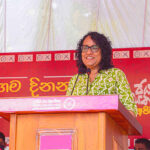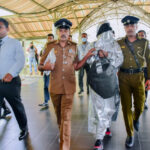
Wide Angle focus on to Rule of Law claims clash with rising violence.
- CNL Reporter
- May 4, 2025
- Weekly Political Review
- NPP, President Anura Kumara Dissanayake
- 0 Comments
Weekly Political Review
May Day spectacle contrasts harsh national security realities
By Rohana Jith
President Anura Kumara Dissanayake’s declaration at the National People’s Power (NPP) May Day rally that his government has successfully “established the Rule of Law in Sri Lanka” would have been amusing, if not for the unsettling contrast with the country’s spiraling underworld violence.
While the Galle Face Green crowd cheered the President’s words, reports of increasing criminal activity and brazen lawlessness elsewhere in the country offered a sobering reality check.
Sri Lanka has witnessed a troubling spike in organized crime and gang violence over the past few months. Between January and February 2025 alone, 22 violent incidents—including 17 shootings and five knife attacks—were recorded.

While 17 of these cases have been resolved, the human cost is high, with 11 lives lost, among them two children aged six and nine. Authorities have identified 58 criminal gangs, encompassing roughly 1,400 members. Many are reportedly operated by overseas-based leaders, making domestic enforcement efforts exceedingly complex.
Although Sri Lankan officials have ramped up extradition efforts—repatriating 19 suspects with Interpol red notices from countries like the UAE and India—the ongoing tide of violence reveals that the government’s grip on public safety remains tenuous. The irony of President Dissanayake’s claim, then, could not be more jarring.
This discord between rhetoric and reality was further illustrated by the chaotic scenes surrounding the NPP’s May Day event itself. In a surreal and telling moment, NPP supporters arriving in buses were seen picnicking on the Southern Expressway, parked along the lanes with little regard for highway regulations.
Shockingly, law enforcement officers were present but stood by idly, seemingly unwilling—or unable—to intervene.
The message was clear: in this new political order, laws may be selectively applied. While past governments, such as that of the Rajapaksas, were roundly criticized for similar behavior, the current administration’s followers seem emboldened by a newfound sense of immunity.
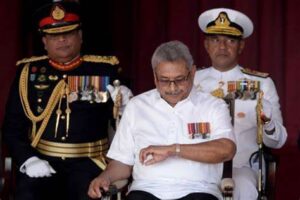
No disciplinary action appears to have been taken against these party members who openly flouted expressway regulations.
This permissive environment feeds into a broader political culture of double standards, where partisan loyalty often trumps principles.
The same voices who once decried infractions under previous regimes now offer excuses or remain silent when faced with similar behavior by the current ruling party.
Yet, the NPP’s May Day rally was significant not only for its theatrics but for what it revealed about the shifting dynamics within Sri Lankan politics. While traditional parties such as the United National Party (UNP) and the Sri Lanka Freedom Party (SLFP) held relatively low-key events—or in the UNP’s case, no official rally at all—the JVP/NPP dominated the day in both scale and message.
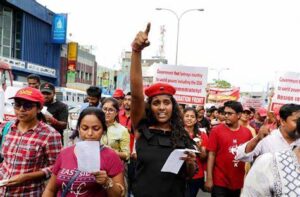
President Dissanayake used his speech to urge trade unions to adapt to new realities. He called on union leaders to move beyond “petty” demands and abandon outdated modes of protest.
Ironically, this comes from the very party that commands the country’s most powerful trade union wing—one that has historically staged prolonged industrial actions with major economic repercussions.
The President’s appeal to unions to avoid disruption and trust in his administration’s intentions was a notable departure from past JVP messaging.
Whether this marks a strategic shift in the JVP/NPP’s approach to labor relations or is merely political posturing remains to be seen. Analysts will be closely watching if the party’s trade union affiliates follow through with this new directive—or, like their UNP and SLFP predecessors, gradually fade into political irrelevance as governing priorities take center stage.
The rally also highlighted the JVP/NPP’s growing regional connections. A Chinese Communist Party (CPC) delegation attended the event and addressed the crowd, as did a representative from the Communist Party of India (Marxist).
However, the latter’s comments sparked controversy, with the UNP issuing a statement condemning anti-India rhetoric from the NPP stage. As regional dynamics become increasingly delicate, especially with China and India vying for influence in Sri Lanka, such moments can carry significant diplomatic weight.
On the international front, the government also engaged in crucial trade and policy discussions. A European Union delegation met with President Dissanayake and Foreign Minister Vijitha Herath to review Sri Lanka’s compliance under the Generalised Scheme of Preferences Plus (GSP+).
A particular sticking point remains Sri Lanka’s long-promised repeal of the Prevention of Terrorism Act (PTA). Although a committee has reportedly been established to draft replacement legislation, the EU’s patience may be wearing thin.
In the U.S. trade arena, contradictions emerged between the President’s public optimism about nearing a bilateral trade deal and statements from Deputy Finance Minister Harshana Suriyapperuma.
According to the Deputy Minister, U.S. officials emphasized that progress depends on Sri Lanka meeting key conditions set by the International Monetary Fund (IMF). Energy-related trade, among other sectors, is being explored as a potential area for collaboration.
Domestically, the government faces backlash from civil society and unions over electricity pricing reforms demanded by the IMF.
Economic Development officials confirmed that cost-reflective tariffs would be implemented by June in line with quarterly IMF requirements—an unpopular but necessary move under the country’s economic recovery program.
In geopolitical news, Sri Lanka’s Defence Secretary met with Pakistan’s Defence Minister in Islamabad during a bilateral security dialogue.
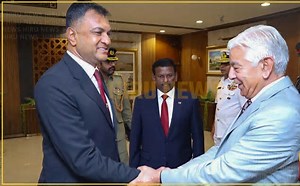
Although India has historically accused Pakistan of fostering terrorism, Sri Lanka’s government maintains its right to engage sovereignly with regional partners. So far, India has responded with guarded neutrality, reiterating its ongoing anti-terror cooperation with Sri Lanka.
Meanwhile, President Dissanayake is currently on an official visit to Vietnam, where he is expected to meet key political leaders and attend the United Nations Day of Vesak as Chief Guest. Several Memoranda of Understanding (MOUs) covering foreign relations, agriculture, industry, and exports are expected to be signed during the visit.
Looking ahead, a high-level Chinese delegation led by Commerce Minister Wang Wentao will visit Sri Lanka in June.
Talks are expected to focus on expanding trade relations and resuming negotiations on the long-stalled China-Sri Lanka Free Trade Agreement (FTA), which broke down in 2018. The resumption of these talks could have significant implications for Sri Lanka’s export strategy and regional alignment.
Amid all these high-stakes developments, Sri Lanka is preparing for Local Government Elections this Tuesday. Public enthusiasm appears muted, with voter turnout expected to decline compared to last year’s national elections.
However, the NPP is treating the elections as a litmus test of its popular support, aiming for a sweeping victory across all local government bodies. Yet signs of fatigue are visible, with reported drops in youth and female participation in the party’s door-to-door campaign efforts.
The NPP insists that these so-called “small elections” are vital for grassroots development. But the results will also serve as a referendum on how voters’ view the government’s credibility—particularly in light of the widening gap between promises of reform and the realities on the ground.
As Sri Lanka continues its precarious balancing act between domestic order and international expectation, the coming weeks may prove decisive in determining whether the new political order can maintain its momentum—or whether contradictions between rhetoric and reality will begin to unravel its foundation.
